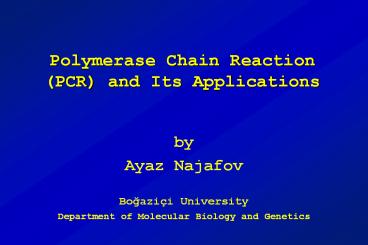Polymerase Chain Reaction (PCR) and Its Applications - PowerPoint PPT Presentation
1 / 32
Title:
Polymerase Chain Reaction (PCR) and Its Applications
Description:
Title: PCR and Its Applications Subject: PCR Author: Ayaz Najafov Keywords: PCR, applications, molecular identification, cloning Description: To be presented on 9th ... – PowerPoint PPT presentation
Number of Views:1252
Avg rating:3.0/5.0
Title: Polymerase Chain Reaction (PCR) and Its Applications
1
Polymerase Chain Reaction (PCR) and Its
Applications
- by
- Ayaz Najafov
- Bogaziçi University
- Department of Molecular Biology and Genetics
2
What is PCR?
PCR is an exponentially progressing synthesis of
the defined target DNA sequences in vitro.
It was invented in 1983 by Dr. Kary Mullis, for
which he received the Nobel Prize in Chemistry in
1993.
3
What is PCR? Why Polymerase?
It is called polymerase because the only enzyme
used in this reaction is DNA polymerase.
4
What is PCR? Why Chain?
It is called chain because the products of the
first reaction become substrates of the following
one, and so on.
5
What is PCR? The Reaction Components
1) Target DNA - contains the sequence to be
amplified.
2) Pair of Primers - oligonucleotides that define
the sequence to be amplified.
3) dNTPs - deoxynucleotidetriphosphates DNA
building blocks.
4) Thermostable DNA Polymerase - enzyme that
catalyzes the reaction
5) Mg ions - cofactor of the enzyme
6) Buffer solution maintains pH and ionic
strength of the reaction solution suitable for
the activity of the enzyme
6
The Reaction
PCR tube
THERMOCYCLER
7
Denature (heat to 95oC)
Lower temperature to 56oC Anneal with primers
Increase temperature to 72oC DNA polymerase
dNTPs
8
(No Transcript)
9
(No Transcript)
10
(No Transcript)
11
Applications of PCR
- Detection of pathogens
- DNA fingerprinting
- Drug discovery
- Genetic matching
- Genetic engineering
- Pre-natal diagnosis
- Classification of organisms
- Genotyping
- Molecular archaeology
- Mutagenesis
- Mutation detection
- Sequencing
- Cancer research
12
Applications of PCR
Basic Research
Applied Research
- Mutation screening
- Drug discovery
- Classification of organisms
- Genotyping
- Molecular Archaeology
- Molecular Epidemiology
- Molecular Ecology
- Bioinformatics
- Genomic cloning
- Site-directed mutagenesis
- Gene expression studies
- Genetic matching
- Detection of pathogens
- Pre-natal diagnosis
- DNA fingerprinting
- Gene therapy
13
Applications of PCR
Molecular Identification
Sequencing
Genetic Engineering
- Bioinformatics
- Genomic cloning
- Human Genome Project
- Site-directed mutagenesis
- Gene expression studies
- Molecular Archaeology
- Molecular Epidemiology
- Molecular Ecology
- DNA fingerprinting
- Classification of organisms
- Genotyping
- Pre-natal diagnosis
- Mutation screening
- Drug discovery
- Genetic matching
- Detection of pathogens
14
MOLECULAR IDENTIFICATION
15
(No Transcript)
16
Detection of Unknown Mutations
Molecular Identification
17
SSCP gels shifts
representing a mutation in the amplified DNA
fragment
18
Classification of Organisms
Molecular Identification
1) Relating to each other 2) Similarities 3)
Differences
Fossils Trace amounts Small organisms
! DNA !
19
(No Transcript)
20
Rademaker et al. 2001
21
Detection Of Pathogens
Molecular Identification
22
Detection Of Pathogens
Molecular Identification
Sensitivity of detection of PCR-amplified M.
tuberculosis DNA. (Kaul et al.1994)
23
Sensitivity of detection of PCR-amplified M.
tuberculosis DNA. (Kaul et al.1994)
24
Genotyping by STR markers
Molecular Identification
25
Prenatal Diagnosis
Molecular Identification
- Chorionic Villus
- Amniotic Fluid
Molecular analysis of a family with an autosomal
recessive disease.
26
SEQUENCING
Nucleotides (dNTP) are modified
(dideoxynucleotides ddNTP)
NO polymerisation after a dideoxynucleotide!
Fragments of DNA differing only by one nucleotide
are generated
radioactive
Nucleotides are either or
fluorescent
27
(No Transcript)
28
Classical Sequencing Gel
Sequencing
29
Reading Classical Sequencing Gels
Sequencing
30
Sequencing
31
Summary
blood, chorionic villus, amniotic fluid, semen,
hair root, saliva
68,719,476,736 copies
Gel Analysis, Restriction Digestion, Sequencing
32
Conclusion
The speed and ease of use, sensitivity,
specificity and robustness of PCR has
revolutionised molecular biology and made PCR
the most widely used and powerful technique with
great spectrum of research and diagnostic
applications.

